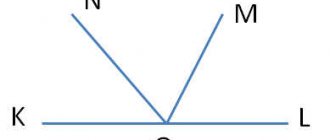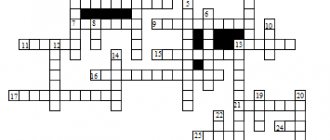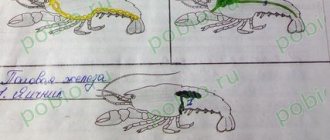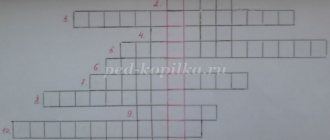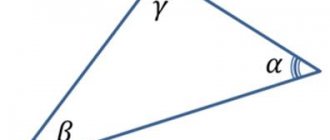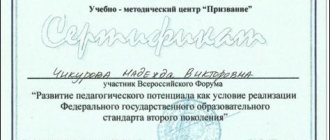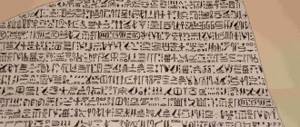Glossary of terms in mathematics from A to Z
An axiom is a statement accepted without evidence.
An algebraic expression is a number of numbers, designated by letters or numbers and connected using the operations of addition, subtraction, multiplication, division, exponentiation and root extraction.
Abcissa (French word). One of the Cartesian coordinate points. Is the first. Typically indicated by the symbol "X". First used by G. Leibniz in 1675 (German scientist).
Additivity. Some property of quantities. It says the following: the value of a certain quantity corresponding to a full-fledged object is equal to the sum of the values of such a quantity that correspond to its parts in any division of the full-fledged object into parts.
Adjunct. Completely corresponds to algebraic complement.
Axonometry. One of the ways to depict spatial figures on a plane.
Algebra. The part of mathematics that studies problems and solutions of algebraic equations. The term was first seen in the 11th century. Used Muhammeda ben-Musa al-Khwarizmi (mathematician and astronomer).
Argument (functions). A variable quantity (independent) with the help of which the value of a function is determined.
Arithmetic. The science that studies operations with numbers. Originated in Babylon, India, China, Egypt.
Asymmetry. Absence or violation of symmetry (reverse meaning of symmetry).
An infinitely large value is greater than any predetermined number.
An infinitesimal quantity is smaller than any finite quantity.
Billion. One thousand million (one followed by nine zeros).
Bisector. A ray that starts at the vertex of an angle (divides the angle into two parts).
Vector. A directed segment is a straight line. One end is the beginning of the vector; the other is the end of the vector. The term was first used by W. Hamilton (Irish scientist).
Vertical angles. A pair of angles that have a common vertex (formed by the intersection of two straight lines in such a way that the side of one angle is a direct continuation of the second).
A vector is a quantity characterized not only by its numerical value, but also by its direction.
A graph is a drawing that clearly depicts the dependence of one quantity on another, a line that gives a visual representation of the nature of the change in a function.
Hexahedron. Hexagon. The term was first used by Pappa of Alexandria (an ancient Greek scholar).
Geometry. The part of mathematics that studies spatial shapes and relationships. The term was first used in Babylon/Egypt (5th century BC).
Hyperbola. An open curve (consists of two unlimited branches). The term appeared thanks to Apollonius of Perm (ancient Greek scientist).
Hypocycloid. This is the curve that a point on a circle describes.
Homothety. The arrangement of figures (similar) among themselves, in which the straight lines connecting the points of these figures intersect at the same point (this is called the center of homothety).
Degree. Unit of measurement for a plane angle. Equal to 1/90 of a right angle. Measuring angles in degrees began more than 3 centuries ago. Such measurements were first used in Babylon.
Deduction. Form of thinking. With its help, any statement is deduced logically (based on the rules of the modern science of “logic”).
Diagonal. A straight line segment that connects the vertices of a triangle (they do not lie on the same side). Euclid (3rd century BC) first used the term.
Discriminant. An expression made up of quantities that define a function.
A fraction is a number made up of a whole number of fractions of a unit. Expressed as the ratio of two integers m/n, where m is the numerator, showing how many parts of a unit are contained in the fraction, and n is the denominator, showing how many parts the unit is divided into.
Denominator. Numbers that make up a fraction.
The golden ratio is the division of a segment into two parts so that the larger part is related to the smaller one in the same way as the entire segment is related to the larger part. Approximately equal to 1.618. A criterion of beauty, used in architecture, etc. The term was introduced by Leonardo da Vinci.
Index. Alphabetic or numeric index. With its help, mathematical expressions are supplied (this is done in order to distinguish them from each other).
Induction. Method for proving a mathematical equation.
Integral. Basic concept of mathematical analysis. It arose due to the need to measure volumes and areas.
Irrational number. A number that is not rational.
Katet. One of the sides of a right triangle that is adjacent to a right angle.
Square. Regular quadrilateral (or rhombus). Each corner of a square is straight. All angles in a square are equal (90 degrees).
Mathematical constant. A quantity that never changes in its meaning. A constant is the opposite number for a variable.
Cone. A body that is bounded by a single cavity by a conical surface. It intersects the plane (the plane is perpendicular to its axis).
Cosine. It is one of the trigonometric functions. The notation in mathematics/higher mathematics is cos.
The root of the equation is the solution, the value of the unknown, found through the known coefficients.
Constant is a constant value.
Coordinates are numbers that determine the position of a point on a plane, surface or in space.
Logarithm. Exponent "m". It must be raised to the power "a" in order to obtain a certain number NT. The logarithm was first proposed by J. Napier.
A line is the common part of two adjacent areas of a surface.
Maximum. The greatest value of the function.
Scale. The relationship of two linear dimensions to each other. Used in many modern industries. The main ones are cartography and geodesy.
Matrix. Rectangular table. Formed using a set of numbers (defined). Includes columns and rows (matrix structure). The term “matrix” first appeared from the scientist J. Sylvester.
Median. A segment that connects the vertex of a triangle and its midpoint on the opposite side.
Minimum. The smallest value of the function.
Polygon. Geometric figure. Definition: closed polyline.
Module. Absolute value (of a real number).
A set is a collection of elements united according to some characteristic.
Norm. The absolute value of a number.
An inequality is two numbers or expressions connected by (greater than) or (less than) signs.
Oval. A convex, closed figure (flat).
Circle. Numerous points located on a plane.
Ordinate. One of the Cartesian coordinates. It is usually designated as the second one.
Octahedron. Geometric figure. One of the five polyhedra (regular). The octahedron includes 8 faces (regular), 6 vertices and 12 edges.
Parallelepiped. Prism. The base is a parallelogram or a polyhedron (equivalent concepts). Has 6 edges. Each face is a parallelogram.
Parallelogram. Quadrangle. Its opposite sides are parallel (in pairs). At the moment there are 2 special cases of parallelogram: rhombus and square. The main property of this geometric figure: • Opposite sides are equal; • Opposite angles are equal.
Perimeter. The sum of all sides of a geometric figure. It was first discovered by Archimedes and Heron (ancient Greek scientists).
Perpendicular. A straight line that intersects a plane (any plane) at a right angle.
Pyramid. Polyhedron. Its base is a polygon. Any other face is a triangle (these faces have a common vertex). At the moment, pyramids can be of various types: triangular, quadrangular, and so on (they are distinguished by determining the number of angles).
Planimetry. One of the most important parts of elementary (simple) geometry. Planimetry studies the properties of figures that are on a plane. The term was first coined by Euclid (an ancient Greek scientist).
Plus. A sign that denotes a mathematical operation - addition. In addition, the plus symbol denotes positive numbers. The sign was first introduced by J. Widman (the famous Czech scientist).
Limit. Basic concept of mathematics. Denotes: a variable quantity approaches a constant value (determined) indefinitely. The term was first used by the famous scientist Newton.
Prism. Polyhedron. The first 2 faces are equal triangles (these are the bases of the prism). The rest is the side edges.
Projection. One of the ways to depict spatial and plane figures.
A variable is a quantity whose numerical value changes according to a specific, known or unknown law.
A plane is the simplest surface. Any straight line connecting two of her points belongs entirely to her.
A straight line is a set of points common to two intersecting planes.
A percentage is a hundredth part of a number.
Radian. Unit for measuring angles.
Rhombus. Parallelogram. All sides of this figure are equal. A rhombus with right angles is called a square.
Segment. Part of a circle (it is limited by a chord that connects the ends of the arc).
Secant. Trigonometric function. Notation in Mathematics/Higher Mathematics - sec.
Sector. Part of a circle. Limited by a circle + two radii (connects the ends of one arc to the center of the circle).
Symmetry - correspondence.
Sinus. Trigonometric function. The notation in mathematics/higher mathematics is sin.
Stereometry. Part of elementary geometry. Engaged in the study of full-fledged spatial figures.
Tangent. Trigonometric function. The notation in mathematics/higher mathematics is tg.
Tetrahedron. Polyhedron, includes 4 triangular faces. Each vertex has 3 faces (converging at the vertices). A tetrahedron has 4 faces + 6 edges + 4 vertices.
Dot. Does not have a definite and final concept. Any point is designated using the letters A, B, C.
Triangle. Polygon (simple). Includes 3 tops + 3 sides;
A theorem is a statement that needs to be proven based on axioms and previously proven theorems.
An identity is an equality that is valid for all values of the coefficients included in it.
Topology is a branch of mathematics that studies the properties of figures that do not change under any deformation, without breaking or gluing.
An equation is a mathematical representation of the problem of finding the values of unknowns for which the values of two given functions are equal.
Corner. Geometric figure (flat). It is formed by two rays that come out from one point (the points are the vertices of the angle).
Factorial is the product of natural numbers from 1 to any given natural number n. Denoted by n!. Factorial of zero oh! = 1.
A formula is a combination of mathematical symbols that expresses a proposition.
A function is a numerical relationship between elements of two sets, in which one element of one set corresponds to a certain element of another set. Can be specified by a formula or graph.
Chord. A segment that connects 2 points on a circle.
Numbers are signs to indicate numbers.
Center. The middle of something (for example: a circle).
Cylinder. A body that is limited by a cylindrical surface + parallel planes (two). For the first time, the concept of “cylinder” could be found in Euclid and Aristarchus.
Compass. A special device designed for drawing arcs, linear measurements and circles.
Numerator. A specific number used to form a fraction. The term was first used by Maximus Planuda (Byzantine scientist).
Number is one of the basic concepts of mathematics, which arose in connection with counting individual objects.
Ball. Geometric body. It is the total set of all points in a certain space.
Exhibitor. Is the same as the exponential function. The term was first introduced by G. Leibniz (German scientist).
Ellipse. Oval curve. This term was first introduced by Apollonius of Perga (ancient Greek scientist).
Dictionary of geometric concepts grade 7-8
Geometry, 7-9 Basic definitions, theorems, formulas
Grade 7 Chapter I Basic geometric information
Primary concepts: point, line, plane, space
, segment, ray, angle, equal figures, midpoint of a segment, angle bisector, measurement of segments, measurement of angles
Line segment
-part of a line bounded by two points.
Ray
- part of a straight line bounded by a point on one side and unbounded on the other side.
Corner
- part of the plane limited by two rays emanating from one point.
Equal figures
-shapes that coincide when superimposed on each other.
Midpoint of the segment
- a point on a segment dividing it in half.
Angle bisector
- a ray emerging from the top of an angle and dividing it in half.
Units of length
segments: millimeters, centimeters, decimeters, meters, kilometers.
Angle units
: degrees, minutes, seconds.
Section length
- the number of units of length that fit between the two ends of a segment.
Degree measure of angle
-the number of angle units that fit between the sides of the angle.
Right angle
-An angle whose degree measure is 900.
Sharp corner
-An angle whose degree measure is less than 900.
Obtuse angle
-an angle whose degree measure is greater than 900 but less than 1800.
Full angle
-An angle whose degree measure is 1800.
Adjacent angles
- these are two angles in which one side is common, and the other two form a straight line.
Property
: The sum of adjacent angles is 1800.
Vertical angles
- two angles in which the sides of one angle are a continuation of the sides of the other.
Property
: vertical angles are equal.
Perpendicular lines
-straight lines that, when intersecting, form a right angle.
Parallel lines
- straight lines lying in the same plane and having no common points.
Chapter II Triangles
Triangle
-a figure consisting of three points connected by segments. The points are the vertices of the triangle, the segments are the sides of the triangle.
Perimeter
– the sum of the lengths of all sides.
Theorem (the first sign of equality of triangles
): if two sides and the angle between them of one triangle are respectively equal to two sides and the angle between them of another triangle, then such triangles are congruent.
Theorem
: from a point not lying on a line, you can draw a perpendicular to this line, and only one.
Median of a triangle
is a segment connecting the vertex of a triangle with the middle of the opposite side.
Bisector of a triangle
- a segment of the bisector of an angle of a triangle connecting the vertex of the triangle with a point on the opposite side.
Triangle height
- a perpendicular drawn from the vertex of a triangle to a line containing the opposite side.
Isosceles triangle
- a triangle with two equal sides. Equal sides are the sides, the third side is the base.
Equilateral triangle
- a triangle with all sides equal.
Property
: In an isosceles triangle, the angles at the base are equal.
Property
: In an isosceles triangle, the bisector drawn to the base is the median and altitude.
Theorem (second sign of equality of triangles)
: if a side and two adjacent angles of one triangle are respectively equal to a side and two adjacent angles of another triangle, then such triangles are congruent.
Theorem (third sign of equality of triangles)
: If three sides of one triangle are respectively equal to three sides of another triangle, then such triangles are congruent.
Circle
- a geometric figure consisting of all points of the plane located at a given distance from a given center point.
Circle radius
- a segment connecting any point on a circle with its center.
Chord
- a segment connecting any two points on a circle.
Diameter
-chord passing through the center.
Arc
– part of a circle bounded by two points.
The main tasks for constructing with a compass and ruler:
- constructing a segment equal to a given one
- constructing an angle equal to a given one
- constructing an angle bisector
- constructing the midpoint of a segment
- constructing perpendicular lines
Chapter III Parallel lines
When two straight lines intersect with a third straight transversal, the following types of angles are formed:
- crosswise angles
- one-sided angles
- corresponding angles
Theorem (the first sign of parallel lines)
: If, when two lines intersect with a transversal, the lying angles are equal, then the lines are parallel.
Theorem (second sign of parallel lines):
If, when two lines intersect with a transversal, the corresponding angles are equal, then the lines are parallel.
Theorem (third sign of parallel lines)
: if, when two lines intersect with a transversal, the sum of the internal one-sided angles is equal to the angles equal to 1800, then the lines are parallel.
Axiom
: through a point not lying on a given line there passes only one line parallel to the given one.
Theorem
: If a line intersects one of two parallel lines, then it also intersects the other.
Theorem
: If two lines are parallel to a third line, then they are parallel.
Theorem
: If two parallel lines are intersected by a transversal, then the intersecting angles are equal.
Theorem
: If two parallel lines are intersected by a transversal, then the corresponding angles are equal.
Theorem
: If two parallel lines are intersected by a transversal, then the sum of the interior one-sided angles is 1800.
Chapter IV Relationships between sides and angles of a triangle
Theorem
: The sum of the interior angles of a triangle is 1800.
External angle of a triangle
-An angle adjacent to any interior angle of a triangle.
Acute triangle
is a triangle with all interior angles acute.
Obtuse triangle
is a triangle in which one of the angles is obtuse.
Right triangle
is a triangle with one of its angles being a right angle.
Hypotenuse
is the side of a right triangle that lies opposite the right angle.
Legs
- these are the sides of a right triangle that form a right angle.
Theorem
: In a triangle, the larger angle lies opposite the larger side.
Theorem
: In a triangle, the larger side lies opposite the larger angle.
Consequence
: In a right triangle, the hypotenuse is always greater than the leg.
Theorem (test of isosceles triangle)
: If two angles in a triangle are equal, then it is isosceles.
Theorem(triangle inequality)
:Each side of a triangle is less than the sum of the other two sides.
Property
: The sum of two acute angles of a triangle is 900.
Property
: the leg of a right triangle lying opposite an angle of 300 is equal to half the hypotenuse.
Property
: If a leg of a right triangle is equal to half the hypotenuse, then it lies opposite an angle of 300.
Theorem (equality test for right triangles)
: If the legs of one right triangle are equal to the legs of another right triangle, then such triangles are congruent.
Theorem (test for the equality of right triangles):
if a leg and an adjacent acute angle of one right triangle are equal to a leg and an adjacent acute angle of another right triangle, then such triangles are congruent.
Theorem (equality test for right triangles)
: If the hypotenuse and acute angle of one right triangle are equal to the hypotenuse and acute angle of another right triangle, then such triangles are congruent.
Theorem (equality test for right triangles)
: If the leg and hypotenuse of one right triangle are equal to the leg and hypotenuse of another right triangle, then such triangles are congruent.
Distance from point to line
is the length of the perpendicular drawn from this point to the straight line.
Theorem
: all points of each of two parallel lines are equidistant from the other line.
8th grade. Chapter V Quadrilaterals
Polygon
- a figure consisting of several points of the plane, alternately connected to each other by non-intersecting segments.
Diagonal
is a segment connecting two non-adjacent vertices of a polygon.
Convex polygon
is a polygon that lies entirely on one side of each straight line passing through its two adjacent vertices.
Theorem
:The sum of the interior angles of a convex n-gon is (n-2)*1800.
Parallelogram
is a quadrilateral whose opposite sides are parallel in pairs.
Property
: In a parallelogram, opposite sides are equal and opposite angles are equal.
Property
: The diagonals of a parallelogram are divided in half by the point of intersection.
Theorem (parallelogram test)
:If two sides of a quadrilateral are equal and parallel, then this quadrilateral is a parallelogram.
Theorem (parallelogram test)
:If in a quadrilateral the opposite sides are equal in pairs, then this quadrilateral is a parallelogram.
Theorem (parallelogram test)
: If in a quadrilateral the diagonals intersect and are divided in half by the point of intersection, then this quadrilateral is a parallelogram.
Trapezoid
is a quadrilateral in which two sides are parallel and the other two are not parallel. Parallel sides are the bases, non-parallel sides are the sides.
Isosceles trapezoid
is a trapezoid whose sides are equal.
Rectangular trapezoid
is a trapezoid with one of its angles being right.
Thales's theorem
: if several equal segments are laid out in succession on one of two lines and parallel lines are drawn through their ends, intersecting the second line, then they will cut off equal segments on the second line.
Rectangle
is a parallelogram in which all angles are right.
Property
: The diagonals of the rectangle are equal.
Theorem (rectangle sign):
If the diagonals of a parallelogram are equal, then this parallelogram is a rectangle.
Rhombus
is a parallelogram in which all sides are equal.
Property
: The diagonals of a rhombus are mutually perpendicular and bisect its angles.
Square
is a rectangle with all sides equal.
Chapter VI Area
The area of a flat figure is the number of unit squares that fit into a given figure.
Units of area measurement: mm2, cm2, dm2, m2, ar=100m2, km2, ha=100km2.
Square area
equal to the square of its side.
Area of a rectangle
equal to the product of its adjacent sides.
Area of a parallelogram
equal to the product of its base and its height.
Area of a triangle
equal to half the product of its base and height.
Area of a right triangle
equal to the product of its legs.
If the heights of two triangles are equal, then their areas are related as their bases.
If the angle of one triangle is equal to the angle of another triangle, then the areas of these triangles are related as the product of the sides enclosing equal angles.
Area of trapezoid
equal to half the sum of its bases and its height.
Pythagorean theorem
: In a right triangle, the square of the hypotenuse is equal to the sum of the squares of the legs.
Theorem(arr.)
: If the square of one side of a triangle is equal to the sum of the squares of its other two sides, then the triangle is right-angled.
Chapter VII Similar Triangles
Segments
m and n are proportional to
segments m1 and n1 if the ratios of their lengths are equal to m: m1 = n: n1.
Similar triangles
- These are triangles in which corresponding angles are equal and similar sides are proportional.
Similarity coefficient-
this number is equal to the ratio of similar sides of similar triangles.
Theorem
: The ratio of the areas of two similar triangles is equal to the square of the similarity coefficient.
Property of the bisector of the tr-ka:
The bisector of a triangle divides the opposite side into segments proportional to the adjacent sides of the triangle.
Theorem (the first sign of similarity of triangles)
: If two angles of one triangle are equal to two angles of another triangle, then such triangles are similar.
Theorem (second sign of similarity of triangles
): if two sides of one triangle are proportional to two sides of another triangle and the angles enclosed between these sides are equal, then such triangles are similar.
Theorem (the first sign of similarity of triangles)
: If three sides of one triangle are proportional to three sides of another triangle, then such triangles are similar.
Middle line of the triangle
- This is a segment connecting the midpoints of its two sides.
Theorem
: The midline of a triangle is parallel to one of its sides and equal to half of that side.
C. The altitude of a right triangle drawn from the vertex of a right angle divides the triangle into two similar right triangles, each of which is similar to the given triangle.
The proportional mean (geometric mean) of two quantities is the square root of the product of these quantities.
C. The altitude of a right triangle drawn from the vertex of a right angle is the average proportional between the segments into which the hypotenuse is divided by this altitude.
C. The leg of a right triangle is the mean proportional between the hypotenuse and the segment of the hypotenuse enclosed between the leg and the altitude drawn from the vertex of the right angle.
Sinus
The acute angle of a right triangle is the ratio of the opposite side to the hypotenuse.
Cosine
The acute angle of a right triangle is the ratio of the adjacent leg to the hypotenuse.
Tangent
The acute angle of a right triangle is the ratio of the opposite side to the adjacent side.
Cotangent
The acute angle of a right triangle is the ratio of the adjacent side to the opposite side.
Chapter VIII Circle
Tangent to a circle
is a straight line that has only one common point with a circle.
T. A tangent to a circle is perpendicular to the radius drawn to the point of tangency.
T. (arr.) If a straight line passes through the end of a radius lying on a circle and is perpendicular to this radius, then it is a tangent.
Central angle
is an angle with its vertex at the center of the circle.
Arc of a circle
measured by the central angle that rests on it.
Inscribed angle
An angle whose vertex lies on a circle and whose sides intersect the circle.
T. An inscribed angle is equal to half the arc on which it rests.
C. Inscribed angles subtending the same arc are equal.
C. An inscribed angle subtended by a semicircle is a right angle.
T. If two chords of a circle intersect, the product of the segments of one chord is equal to the product of the segments of the other chord.
9th grade
Midline of trapezoid
- this is a segment connecting the midpoints of its sides.
Theorem
: The midline of a trapezoid is equal to half the sum of its bases and parallel to them.
SOSHI "Umid"
Mathematics (ancient Greek μᾰθημᾰτικά < ancient Greek μάθημα - study, science) is the science of structures, order and relationships, historically developed on the basis of the operations of counting, measuring and describing the shape of objects. Mathematical objects are created by idealizing the properties of real or other mathematical objects and writing these properties in a formal language.
Mathematics does not belong to the natural sciences, but is widely used in them both for the precise formulation of their content and for obtaining new results. Mathematics is a fundamental science that provides (general) language tools to other sciences; Thus, it reveals their structural relationship and contributes to the discovery of the most general laws of nature.
We present to your attention a dictionary of mathematical terms.
Abscissa - (Latin word abscissa - “cut off”). Borrowing from French language at the beginning of the 19th century Franz. abscisse - from lat. This is one of the Cartesian coordinates of a point, usually the first, denoted by x. In the modern sense, T. was first used by the German scientist G. Leibniz (1675).
Additivity - (Latin word additivus - “added”). The property of quantities, consisting in the fact that the value of the quantity corresponding to the whole object is equal to the sum of the values of quantities corresponding to its parts for any division of the object into parts.
Adjunct - (Latin word adjunctus - “attached”). This is the same as algebraic complement.
Axiom - (Greek word axios- valuable; axioma - “acceptance of position”, “honor”, “respect”, “authority”). In Russian - since Peter's times. This is a basic proposition, a self-evident principle. T. is first found in Aristotle. Used in Euclid's Elements. An important role was played by the work of the ancient Greek scientist Archimedes, who formulated axioms related to the measurement of quantities. Contributions to axiomatics were made by Lobachevsky, Pash, Peano. A logically impeccable list of geometry axioms was indicated by the German mathematician Hilbert at the turn of the 19th and 20th centuries.
Axonometry - (from the Greek words akon - “axis” and metrio - “I measure”). This is one of the ways to depict spatial figures on a plane.
Algebra - (Arabic word "al-jabr"). This is a part of mathematics that develops in connection with the problem of solving algebraic equations. T. first appears in the work of the outstanding mathematician and astronomer of the 11th century, Muhammad ben Musa al-Khwarizmi.
Analysis - (Greek word analozis - “decision”, “resolution”). T. "analytic" goes back to Vieta, who rejected the word "algebra" as barbaric, replacing it with the word "analysis".
Analogy - (Greek word analogia - “correspondence”, “similarity”). This is an inference based on the similarity of particular properties of two mathematical concepts.
Antilogarithm - (Latin word nummerus - “number”). This number, which has a given table value of the logarithm, is denoted by the letter N.
Antier - (French word entiere - “whole”). This is the same as the integer part of a real number.
Apothem - (Greek word apothema, apo - “from”, “from”; thema - “attached”, “delivered”). 1. In a regular polygon, an apothem is a perpendicular segment dropped from its center to any of its sides, as well as its length. 2. In a regular pyramid, the apothem is the height of any of its side faces. 3. In a regular truncated pyramid, the apothem is the height of any of its side faces.
Applicata - (Latin word applicata - “attached”). This is one of the Cartesian coordinates of a point in space, usually the third, denoted by the letter Z.
Approximation - (Latin word approximo - “approximating”). Replacement of some mathematical objects with others, in one sense or another close to the original ones.
Function argument (Latin word argumentum – “object”, “sign”). This is an independent variable whose values determine the values of the function.
Arithmetic (Greek word arithmos - “number”). This is the science that studies operations with numbers. Arithmetic originated in the countries of Dr. East, Babylon, China, India, Egypt. Special contributions were made by: Anaxagoras and Zeno, Euclid, Eratosthenes, Diophantus, Pythagoras, L. Pisansky and others.
Arctangent, Arcsine (prefix “arc” - the Latin word arcus - “bow”, “arc”). Arcsin and arctg appear in 1772 in the works of the Viennese mathematician Schaeffer and the famous French scientist J.L. Lagrange, although they had already been considered somewhat earlier by D. Bernoulli, but who used different symbolism.
Asymmetry (Greek word asymmetria - “disproportion”). This is the absence or violation of symmetry.
Asymptote (Greek word asymptotes - “non-coincident”). This is a straight line to which the points of a certain curve approach indefinitely as these points move away to infinity.
Astroid (Greek word astron - “star”). Algebraic curve.
Associativity (Latin word associatio - “connection”). Combination law of numbers. T. was introduced by W. Hamilton (1843).
Billion (French word billion, or billion – milliard). This is a thousand million, a number represented by one followed by 9 zeros, i.e. number 10 9. In some countries, a billion is a number equal to 10 12.
Binom (Latin words bi - “double”, nomen - “name) is the sum or difference of two numbers or algebraic expressions, called members of a binomial.
Bisector (Latin words bis - “twice” and sectrix - “secant”). Borrowing In the 19th century from French language where bissecrice – goes back to lat. phrase. This is a straight line passing through the vertex of the angle and dividing it in half.
Vector (Latin word vector – “carrying”, “carrier”). This is a directed segment of a straight line, one end of which is called the beginning of the vector, the other end is called the end of the vector. This term was introduced by the Irish scientist W. Hamilton (1845).
Vertical angles (Latin word verticalis - “vertex”). These are pairs of angles with a common vertex, formed by the intersection of two straight lines so that the sides of one angle are a continuation of the sides of the other.
Hexahedron (Greek words geks - “six” and edra - “face”). This is a hexagon. This T. is attributed to the ancient Greek scientist Pappus of Alexandria (3rd century).
Geometry (Greek words geo – “Earth” and metreo – “I measure”). Old Russian borrowed from Greek The part of mathematics that studies spatial relationships and shapes. T. appeared in the 5th century BC. in Egypt, Babylon.
Hyperbole (Greek word hyperballo - “going through something”). Borrowing in the 18th century from lat. language This is an open curve of two unlimitedly extending branches. T. was introduced by the ancient Greek scientist Apollonius of Perm.
Hypotenuse (Greek word gyipotenusa - “contracting”). Deputy from lat. language in the 18th century, in which hypotenusa – from the Greek. the side of a right triangle that lies opposite the right angle. The ancient Greek scientist Euclid (3rd century BC) wrote instead of this term, “the side that subtends a right angle.”
Hypocycloid (Greek word gipo - “under”, “below”). The curve that a point on a circle describes.
Goniometry (Latin word gonio - “angle”). This is the study of "trigonometric" functions. However, this name did not catch on.
Homothety (Greek word homos - “equal”, “same”, thetos - “located”). This is an arrangement of figures that are similar to each other, in which the straight lines connecting the corresponding points of the figures intersect at the same point, called the center of homothety.
Degree (Latin word gradus - “step”, “step”). A unit of measurement for a plane angle equal to 1/90 of a right angle. The measurement of angles in degrees appeared more than 3 years ago in Babylon. Designations reminiscent of modern ones were used by the ancient Greek scientist Ptolemy.
Graph (Greek word graphikos - “inscribed”). This is a graph of a function - a curve on a plane depicting the dependence of the function on the argument.
Deduction (Latin word deductio - “deduction”). This is a form of thinking through which a statement is derived purely logically (according to the rules of logic) from some given statements - premises.
Deferents (Latin word defero - “carry”, “move”). This is the circle around which the epicycloids of each planet rotate. For Ptolemy, the planets rotate in circles - epicycles, and the centers of the epicycles of each planet rotate around the Earth in large circles - deferents.
Diagonal (Greek word dia - “through” and gonium - “angle”). This is a straight line connecting two vertices of a polygon that do not lie on the same side. T. is found in the ancient Greek scientist Euclid (3rd century BC).
Diameter (Greek word diametros - “diameter”, “through”, “measuring” and the word dia - “between”, “through”). T. “division” in Russian is first found in L.F. Magnitsky.
Directress (Latin word directrix - “director”).
Discreteness (Latin word discretus – “divided”, “discontinuous”). This is discontinuity; opposed to continuity.
Discriminant (Latin word discriminans - “discriminating”, “separating”). This is an expression made up of quantities defined by a given function, the reversal of which to zero characterizes one or another deviation of the function from the norm.
Distributivity (Latin word distributivus – “distributive”). Distributive law connecting addition and multiplication of numbers. T. was introduced by the French. scientist F. Servois (1815).
Differential (Latin word differento- “difference”). This is one of the basic concepts of mathematical analysis. This T. is found by the German scientist G. Leibniz in 1675 (published in 1684).
Dichotomy (Greek word dichotomia - “division in two”). Method of classification.
Dodecahedron (Greek words dodeka - “twelve” and edra - “base”). This is one of the five regular polyhedra. T. is first encountered by the ancient Greek scientist Theaetetus (4th century BC).
source
